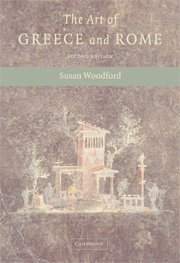Book contents
- Frontmatter
- Contents
- List of Illustrations
- Acknowledgements
- Maps
- Introduction
- PART I THE ARCHAIC AND CLASSICAL PERIODS: PROGRESS AND PROBLEMS
- PART II THE FOURTH CENTURY BC AND THE HELLENISTIC PERIOD: INNOVATION AND RENOVATION
- 4 Sculpture
- 5 Painting
- 6 Architecture and Planning
- PART III THE ROMAN WORLD: ADOPTION AND TRANSFORMATION OF THE GREEK LEGACY
- Epilogue
- Appendix: How We Know What We Think We Know
- Glossary
- Further reading
- Index
4 - Sculpture
- Frontmatter
- Contents
- List of Illustrations
- Acknowledgements
- Maps
- Introduction
- PART I THE ARCHAIC AND CLASSICAL PERIODS: PROGRESS AND PROBLEMS
- PART II THE FOURTH CENTURY BC AND THE HELLENISTIC PERIOD: INNOVATION AND RENOVATION
- 4 Sculpture
- 5 Painting
- 6 Architecture and Planning
- PART III THE ROMAN WORLD: ADOPTION AND TRANSFORMATION OF THE GREEK LEGACY
- Epilogue
- Appendix: How We Know What We Think We Know
- Glossary
- Further reading
- Index
Summary
THE DECLINE OF THE CLASSICAL POLEIS AND THE RISE OF THE HELLENISTIC KINGDOMS
The Peloponnesian War took a heavy toll. Powerful Athens had been defeated, but mighty Sparta had also been weakened. For a little while in the 4th century bc, Thebes gained ascendancy, but it was limited in time and influence. No force seemed able to unite or subjugate the Greek poleis permanently. By the end of the 1st century bc all this had changed. Dominated first by Macedonia and then by Rome, the poleis were never again to have anything more than nominal independence.
Though the Macedonians were Greek-speaking people, they differed profoundly from the citizens of the Greek poleis. They were ruled by kings and lived more or less on the fringes of Greek civilisation. Philip II, who ruled from about the middle of the 4th century bc, nevertheless appreciated what was best in Greek culture. He enticed to his court one of the most renowned Greek philosophers of the day – Aristotle – to act as tutor for his son and also, perhaps, one of the greatest Greek painters, whose name is lost to us, to decorate the royal tombs (Fig. 82). Philip dreamed of leading the Greeks in an expedition against the Persians to avenge the Persian invasion of the early 5th century bc. Through keen political shrewdness and aptly deployed military might, by 338 bc he had conquered or made allies of all the Greek poleis on the mainland.
- Type
- Chapter
- Information
- The Art of Greece and Rome , pp. 59 - 71Publisher: Cambridge University PressPrint publication year: 2004



